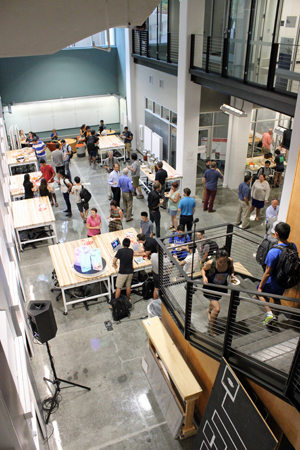Living in Few dorm has its perks, aside from being right beside the bus stop. My faculty-in-residence, Dr. Hwansoo Kim had kindly hosted a reception in his residence, where he invited Dr. Marc Jeuland for a talk about the development of water infrastructure to help improve health. 
I was immediately captivated when I saw the email invite – as I personally had worked with affordable water filtration, in the developing world, so this was right in my field of interest.
Jeuland is an assistant professor in the Sanford School of Public Policy and the Duke Global Health Institute. He shared his experience working on one of his most recent, major projects, which was of his water infrastructure improvements in Zarqa, Jordan. For a long time, Jordan has been experiencing a water crisis. For the residents of Zarqa, water often has to be purchased from other areas, and then carefully preserved for days, or weeks, and even up to a month. The piped water infrastructure that currently existed in Zarqa was very inefficient, and was a major source of the shortages.
Jeuland, who is an environmental engineer, said that as much as 70 percent of this water can be lost from pipelines as the water reaches the citizens of Zarqa. Jeuland worked to assess inefficiencies within the current water supply systems and tried to design and implement improvements to remedy the faults.
Aside from his work in Zarqa, Jeuland has been involved with countless other projects and studies that have ultimately benefited underserved communities around the world. He has characterized the effects of contaminated groundwater on inhabitants in Rift Valley, Ethiopia and done a detailed analysis of the correlation between water quality and kidney disease in Sri Lanka.
Jeuland’s work shows the real-world applicability of interdisciplinary fields. His work has encompassed the field of not only environmental science, but also behavioral science, economics, and engineering.
For those of you interested in learning more about the interdisciplinary fields of global health and environmental sciences/policy, it would definitely be a great idea to take a look at the classes Jeuland teaches, which include “ENVIRON 538: Global Environmental Health: Economics and Policy” and “GLHLTH 531: Cost Benefit analysis for Health and Environmental Policy”.
It was an honor to get to meet Professor Jeuland. I could tell he was a very busy man. By the time you read this, he is probably off traveling somewhere else in the world, working to improve more lives.
 By Thabit Pulak, Class of 2018
By Thabit Pulak, Class of 2018


























